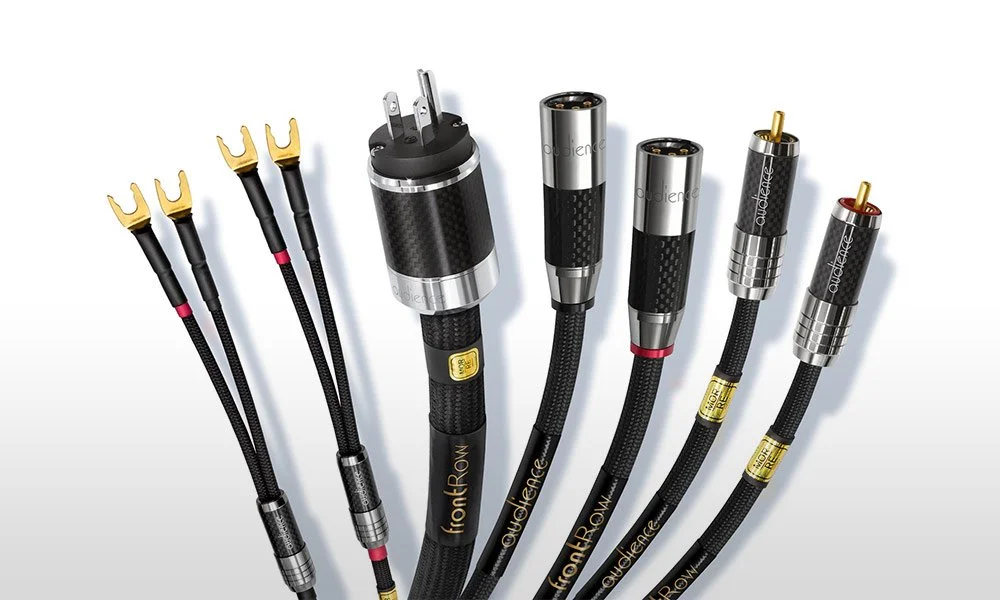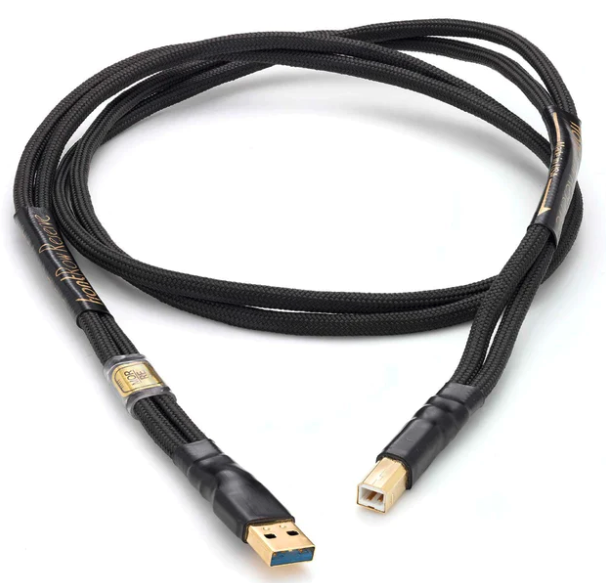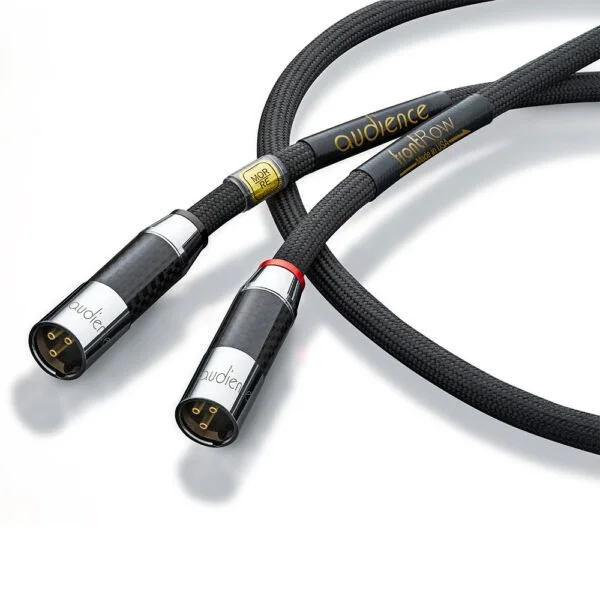AUDIENCE FRONT ROW CABLES- REVIEW
The Electrostatics of High-End Audio Cables!
I remember like it was yesterday, walking into a high-end audio store in San Francisco’s South of Market area. The audio store that I had entered had once been located on San Francisco’s Van Ness Ave. As a young man I would look with an unquenchable desire into its windows to have what sat on the other side. Those in the know will, of course, know exactly which store I refer to.
I was eventually greeted by a salesperson, as I perambulated—as in passing or wandering through or over—about the South of Market store. I was in search of wires and cables to lift and/or free the music that I believed was being held back by my current wires.
“I’m looking for a good set of cables, as my current cables are limiting the music,” I said.
His response, “All cables are the same, don’t you know? There’s no difference between them at all. Hype, snake oil.”
Having experienced a rather wide array of cables by this time, and their various pluses and minuses, I stood shocked for a second. Here was a salesman in a high-end audio store who was a) either completely oblivious to the fact that cables do indeed sound different, or b) he wanted to up-sell me on something other than cables?
I began my brief rebuttal. “Would you agree that different metals—silver, copper, gold, nickel have different conductivities, different resistivities that are inversely proportional? The greater the conductivity the less the resistance?” I asked.
A pregnant silence filled the air.
“Thank you,” I said, and headed for another audio store to seek out my cables.
This is, however, an argument—that cables are “snake oil”—that I have also heard from folks who should know better—audio component manufacturers.
I spoke with one gentleman, a noted manufacturer who shall remain nameless, who was quite adamant that cables made no difference at all, and that they were “snake oil”.
“So,” I asked him, “I imagine that you run RadioShack cable through your preamps/amps and assume that stock power cables are all your buyers will ever need?”
“No,” he replied. “I use XYZ-Cable. It’s the best I’ve come across. You should check it out. It has just the right mix of ‘properties.’”
A pregnant silence filled the air.
It has become quite clear to me across any number of professions, sciences, socio-political belief systems, etc, that some folks may be proficient, skilled, even exceptionally competent in a given area, in which they may hold a valued puzzle piece or even two. However, even in a ‘sub-domain’ of their own field, they may be completely bereft of a single puzzle piece or the wherewithal to find one. Such is life and to this we are all victims.
In my experience, there are differences both great and small between various cables. I would imagine a good part of this are the materials, metals used, the implementation and construction of said wires/cables, the proficiency of that construction, and the experience and expertise of the person/company making those wires/cables. Snake oil? No.
Perhaps the reverse argument that might shed some light on the quality of the above “snake oil” comment would come from, say, a cable manufacturer. “All preamps and amplifiers sound exactly the same. It’s snake oil to think otherwise”, he might say. And that would be very foolish, of course.
This brings me to my review of a cable loom stemming from a rather renowned lineage—Audience’s Front Row Cable (AFRC)—which offers a profound rendering of the musical signals that pass through the loom of wiring. That said, these cables are not inexpensive and for most they might well be qualified as ‘Unobtainium’. However, for those able to afford them, please read on.
REFRAIN: Unlike most reviews, this review will be non-sequential, as it will start, below, with how the equipment actually sounds and not the process of physically “undressing” it and/or laying out its various parts, specifications, etc. Think of this review then, as a non-linear movie—Memento, Kill Bill, Arrival, Eternal Sunshine of the Spotless Mind, The Terminator, In the Shadow of the Moon, The Queen’s Gambit, etc—that, likewise, starts at the end and winds its way to the beginning.
The Sound
The journey, generally, begins at the source. Or more specifically, at the power cord. This time, however, I went in the opposite direction—the digital cable. We reviewers must continually experiment.
I had just received a full loom of the Audience Front Row Cables and it was time to begin its review process in what was a very familiar high-end, electrostatic headphone system—Roon Nucleus Plus streamer, Mola Mola Tambaqui DAC, STAX SR-X9000 headphones, and STAX SRM-T8000 headphone amp.
I began the stepped implementation of the Audience Front Row Cables with the USB cable, which immediately stood in another world compared to previous USB cables in every respect—timbral accuracy, weight, transparency, naturalness, transient speed, and detail (if you can only afford only one of the AFRC cables, get this cable!).
I then implemented the AFR singled-ended (RCA). The difference between it and the previous cables was again stark and the affinity to electrostatics grew. And it continued to grow with the implementation of the balanced interconnects (XLR). I sat listening agog—highly excited by eagerness, curiosity, anticipation, etc.—to this cable loom that was putting up an incredibly convincing demonstration of cable as component and as an electrostatic component at that!
Then I compared the AFR singled-ended (RCA) and balanced cables (XLR). There were clear differences between them. The XLR cables dug deeper into the musical mix pulling up waves of information, banishing even more noise to some distant realm, fleshing out timbre and texture, while expanding the soundstage. The RCA cables on the other hand were a marked improvement over all of the previous cables, but there was a slight lessening of weight and transparency and quiet by comparison, though they were still incredibly communicative, transparent and natural.
I then replaced the power cables to each of the electronic components with the AFR power cables, save the Roon Nucleus Plus, which is not equipped to take an aftermarket power cord. I powered things up and with the briefest of respites, I listened.
Transparency reigned. And its children—resolution, clarity, space, and air—were all present on a level the previous wire looms could not equal. However, in terms of bass response the AFRCs were very dependent on the quality/quantity of the system to which they were engaged. In particular, the AFR power cords were far more susceptible to this factor than the AFR USB digital cables or AFR RCA/XLR cables, which performed flawlessly in a top to bottom implementation, across the width of the frequency spectrum.
Let me explain. In this review I began with the placement of the AFR USB digital cable first which immediately distinguished itself as a profound advancement over all other in-house digital cables. There was simply no contest. And with the implementation of AFR RCA/XLR interconnect cables there came a synergy between the two layers of AFR cables that, seemingly, transported one to an electrostatic awareness and rendering of the music being played. This was truly uncanny. At times, I sat mouth agape as my pen fell away, and all I could do was listen. I do not ever recall a cable being this profound in its ability to well, free a system. And while the final implementation of the AFR power cables sustained this electrostatic rendering, there was, nonetheless, a fall off in bass response potency, depth and weight, depending on the amp in question.
With the Enleum AMP-23R, a Titan of bass response in every respect, there seemed to be no diminishment or only very slight diminishment in bass when the AFR power cables were employed.When the STAX SRM-T8000 was brought in the diminishment was a bit more pronounced, but a slight raising of the volume appeared to somewhat compensate. However, with the Linear Tube Audio (LTA) Z10e there was a marked fall off in bass response in terms of the ability to reach into any of the sub-bass stratum. In this respect, the AFR power cords, unlike the other AFR cables and wires, are very system dependent. This was somewhat mitigated with the LTA Z10e when the XLRs were engaged as they brought better depth extension and tautness to the music, but the sub-bass regions could still not be breached.
The midrange, however, across all genres of music and all configurations was magic. Have you ever been captured by a smile, a voice, a piece of art, a ‘something’ that just wouldn’t let go? Yeah.
And the treble via the AFRCs was so doggone sweet and silky, extended, and electrostatic-like in revelation, that there were times when I just had to stare at the assembled system components and ask, “So you wait until now?”
Tone and Timbre of the AFR cables and wires were superb. So exacting and good at parsing tonal/timbral subtleties that it seemed possible to discern the mass of an instrument or even one triangle relative to another. This was the first time that I had ever felt as if a cable had allowed me to discern the mass of any instrument.
Electrostatic? This was a question that needed to be answered.
I substituted the Enleum AMP-23R integrated system in place of the STAX SRM-T8000 headphone amp and the Meze Empyrean Elite headphones in place of the STAX SR-X9000 headphones. And the answer came quickly, as this system also exhibited a greater transparency, which brought with it the attendant resolution, engagement and a wonderful sweetness, that together conjured an ‘electrostatic-like’ listening experience. Cables are, decidedly, not “snake oil.”
In the words of Audience regarding its Front Row cables, we have an example of truth in marketing going hand in hand with reality:
“frontRow cable design and development opens up a musical performance that is startling in its life-like presentation; removing veils that obscure the essence of the artist’s intention and bringing you into the center of the experience.
Each and every frontRow cable added to your system will reveal just what you have been missing. With the removal of layers of distortion and a dramatic lowering of the noise floor; frontRow will allow you to hear increased dynamics and more low-level information retrieval; with air, space and 3-dimensional holographic imaging unlike you have experienced before.”
As I have mentioned before, it is a rare thing when a company’s marketing materials validate an experience or, in this case, an extended review.
The Audience Front Row Cable’s volumetric cube—sound stage—is vast, even cavernous when called for, and it renders an intimate space fully observed, with its every nuance attended, catalogued. As mentioned above, its transparency, resolution and three-dimensionality are easily and uncannily reminiscent of the world of electrostatics. Positioning and layering, and the air between give at least subjective proof to the notion that the components have been left unwired and we are at some later stage of evolution, a century forward perhaps, and the cables are now ‘air’. Bravo!
The Wrappings and Accessories
The Audience Front Row Cables come in a gloss-black square box. It is minimally printed, substantive, and clean. Inside the box is a black square zippered case that holds the various Front Row Cables and a Certificate of Authenticity. And inside the zippered case a black drawstring pouch that holds the cables. All in all a rather elegant, clean and well-executed package.
The packaging is what one should expect from an expensive Top-of-the-Line product—well designed, elegant, clean.
Design—Look, Feel, and Technology
The AFR cables wore a smooth, black-braided-mesh jacket that was soft to the touch, supple, and, in the case of every cable and cord, quite stylish, with an elegance that carried forth from the packaging.
The AFR USB cable was composed of a thin double-twine of cables with gold-plated USB A and C connections.
The AFR RCA cables were thin and flexible. Their left and right terminations of Rhodium-plated, carbon-fiber connectors were clearly labeled (red, black) and provided for secure connections.
The AFR XLR (balanced) cables were, perhaps, twice the thickness of the RCAs, though still very flexible. Their left and right terminations of silver-plated, carbon-fiber connectors were robust, clearly labeled (red, black) and also provided for secure connections.
The AFR power cords were thick and substantial and terminated with silver-plated, carbon-fiber connectors and IEC and Wall terminations. And yet even they possessed a suppleness that one would not have imagined given their mass. Their connections were tight and quite secure, though you’ll have to exert a wee bit of pressure to insert them into wall sockets or conditioners, etc.
FUNCTIONALITY
Again, like its sibling—BHSE—the GS-X Mini is quite easy to get going and to operate—plug-and-play—with clearly defined choices regarding gain (high or low), input (XLR, RCA), and operational functionality (preamp, no preamp).
The front face of the GS-X Mini from left to right features an On/Off switch, headphone outputs for a ¼” (singled-ended) or XLR (balanced) option, at its center a volume control, and three toggle switches for Gain, Pre-Amp, and Input.
The back facade of the GS-X Mini features, from left to right, a pair of XLR inputs, a pair of RCA inputs, followed by a pair of XLR preamp outputs, and a pair of RCA outputs. On the far right side is the receptacle for the AC input (power cord). It is a simple and straightforward functional design.
Conclusion
The Audience Front Row Cables pulled a very convincing electrostatic imitation on me in the sense that every scintilla of information—data, music—was beautifully revealed and noise was banished to some other distant, non-parallel dimension. Or, at least, it certainly seemed that way. The Audience cables distinguished themselves like the STAX SR-X9000 had done, which ultimately led to the SR-X9000 winning one of our highest awards for 2022. I do not know what, if anything, will displace the Audience Front Row cables from establishing themselves as one of several Best Products of the Year for 2022, as they are truly that good.
There is not another cable, in my experience and to date, that has come close to delivering the kind of transparency, comprehensive resolution and excavation of detail of the AFRCs, in unison with a compelling and immersive musicality and sweetness that I had not thought possible with cables.
These cables are not inexpensive by any means, though what they have achieved and what they offer beyond their like-priced peers - or even their more expensive peers - is so distinguishing that it places them a generation removed in technology from their wire and cable brethren. That they are not more widely known, utilized and lauded, remains for me a mystery.
We, AudioKeyReviews, very highly recommend the Audience Front Row Cables and award them our—GOLD KEYNOTE award—for excellence via an incredible synthesis of transparency, resolution, sublime tonal/timbral accuracy, musicality and sweetness.
Pros: Electrostatic abilities to reveal the totality of one’s music in, literally, any system in which the Audience Front Row cables are employed!
Cons: Bass response dependent on overall bass character of a DAC or amplifying component in direct relation to the AFR power cords. Expensive.
THE SYSTEMS
1.
Roon Nucleus Plus
Mola Mola Tambaqui
Enleum AMP-23R HPA/Integrated
Meze Empyrean Elite
Meze Empyrean
ZMF Atticus
TORUS RM20
2.
Roon Nucleus Plus
Mola Mola Tambaqui
STAX SRM-T8000 HPA
STAX SR-X9000
STAX SR-009S
STAX SR-L700MkII
Dan Clark VOCE
TORUS RM20
3.
Roon Nucleus Plus
Mola Mola Tambaqui
LTA Z10e HPA/Integrated
Meze Empyrean Elite
Meze Empyrean
ZMF Atticus
STAX SR-X9000
STAX SR-009S
STAX SR-L700MkII
Dan Clark VOCE
TORUS RM20
The Company
Audience
Audience Front Row Cables:
Digital—USB: $1,300/m
Interconnects RCA (single-ended): $3300/m
Interconnects XLR (balanced): $3800/m
Power Cords: $6200/6’(ft)
120 N. Pacific Street, K-9
San Marcos, CA 92069
www.audience-av.com
info@audience-av.com






